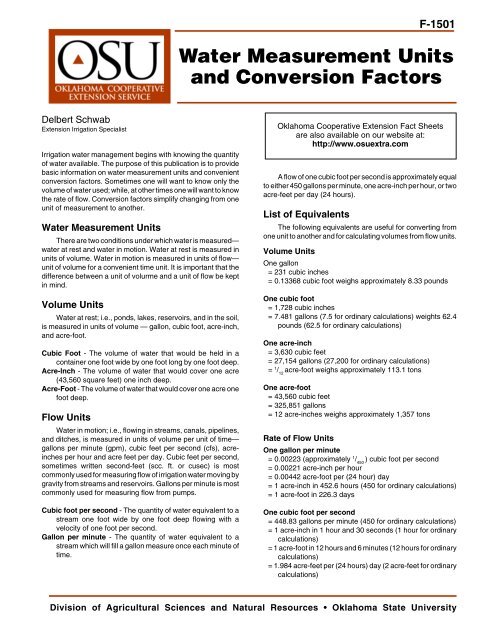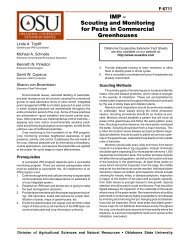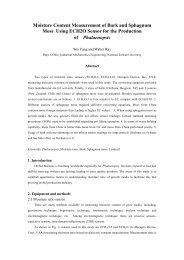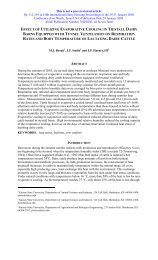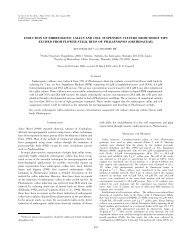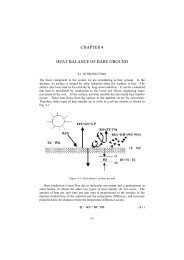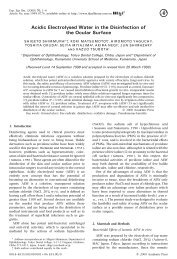Water Measurement Units and Conversion Factors
Water Measurement Units and Conversion Factors
Water Measurement Units and Conversion Factors
Create successful ePaper yourself
Turn your PDF publications into a flip-book with our unique Google optimized e-Paper software.
F-1501<br />
<strong>Water</strong> <strong>Measurement</strong> <strong>Units</strong><br />
<strong>and</strong> <strong>Conversion</strong> <strong>Factors</strong><br />
Delbert Schwab<br />
Extension Irrigation Specialist<br />
Irrigation water management begins with knowing the quantity<br />
of water available. The purpose of this publication is to provide<br />
basic information on water measurement units <strong>and</strong> convenient<br />
conversion factors. Sometimes one will want to know only the<br />
volume of water used; while, at other times one will want to know<br />
the rate of flow. <strong>Conversion</strong> factors simplify changing from one<br />
unit of measurement to another.<br />
<strong>Water</strong> <strong>Measurement</strong> <strong>Units</strong><br />
There are two conditions under which water is measured—<br />
water at rest <strong>and</strong> water in motion. <strong>Water</strong> at rest is measured in<br />
units of volume. <strong>Water</strong> in motion is measured in units of flow—<br />
unit of volume for a convenient time unit. It is important that the<br />
difference between a unit of volurme <strong>and</strong> a unit of flow be kept<br />
in mind.<br />
Volume <strong>Units</strong><br />
<strong>Water</strong> at rest; i.e., ponds, lakes, reservoirs, <strong>and</strong> in the soil,<br />
is measured in units of volume — gallon, cubic foot, acre-inch,<br />
<strong>and</strong> acre-foot.<br />
Cubic Foot - The volume of water that would be held in a<br />
container one foot wide by one foot long by one foot deep.<br />
Acre-lnch - The volume of water that would cover one acre<br />
(43,560 square feet) one inch deep.<br />
Acre-Foot - The volume of water that would cover one acre one<br />
foot deep.<br />
Flow <strong>Units</strong><br />
<strong>Water</strong> in motion; i.e., flowing in streams, canals, pipelines,<br />
<strong>and</strong> ditches, is measured in units of volume per unit of time—<br />
gallons per minute (gpm), cubic feet per second (cfs), acreinches<br />
per hour <strong>and</strong> acre feet per day. Cubic feet per second,<br />
sometimes written second-feet (scc. ft. or cusec) is most<br />
commonly used for measuring flow of irrigation water moving by<br />
gravity from streams <strong>and</strong> reservoirs. Gallons per minute is most<br />
commonly used for measuring flow from pumps.<br />
Cubic foot per second - The quantity of water equivalent to a<br />
stream one foot wide by one foot deep flowing with a<br />
velocity of one foot per second.<br />
Gallon per minute - The quantity of water equivalent to a<br />
stream which will fill a gallon measure once each minute of<br />
time.<br />
Oklahoma Cooperative Extension Fact Sheets<br />
are also available on our website at:<br />
http://www.osuextra.com<br />
A flow of one cubic foot per second is approximately equal<br />
to either 450 gallons per minute, one acre-inch per hour, or two<br />
acre-feet per day (24 hours).<br />
List of Equivalents<br />
The following equivalents are useful for converting from<br />
one unit to another <strong>and</strong> for calculating volumes from flow units.<br />
Volume <strong>Units</strong><br />
One gallon<br />
= 231 cubic inches<br />
= 0.13368 cubic foot weighs approximately 8.33 pounds<br />
One cubic foot<br />
= 1,728 cubic inches<br />
= 7.481 gallons (7.5 for ordinary calculations) weights 62.4<br />
pounds (62.5 for ordinary calculations)<br />
One acre-inch<br />
= 3,630 cubic feet<br />
= 27,154 gallons (27,200 for ordinary calculations)<br />
= 1 / 12<br />
acre-foot weighs approximately 113.1 tons<br />
One acre-foot<br />
= 43,560 cubic feet<br />
= 325,851 gallons<br />
= 12 acre-inches weighs approximately 1,357 tons<br />
Rate of Flow <strong>Units</strong><br />
One gallon per minute<br />
= 0.00223 (approximately 1 / 450<br />
) cubic foot per second<br />
= 0.00221 acre-inch per hour<br />
= 0.00442 acre-foot per (24 hour) day<br />
= 1 acre-inch in 452.6 hours (450 for ordinary calculations)<br />
= 1 acre-foot in 226.3 days<br />
One cubic foot per second<br />
= 448.83 gallons per minute (450 for ordinary calculations)<br />
= 1 acre-inch in 1 hour <strong>and</strong> 30 seconds (1 hour for ordinary<br />
calculations)<br />
= 1 acre-foot in 12 hours <strong>and</strong> 6 minutes (12 hours for ordinary<br />
calculations)<br />
= 1.984 acre-feet per (24 hours) day (2 acre-feet for ordinary<br />
calculations)<br />
Division of Agricultural Sciences <strong>and</strong> Natural Resources • Oklahoma State University
<strong>Conversion</strong> Table for units of flow.<br />
Cubic Gallons Million Acre-Inches Acre-Feet<br />
<strong>Units</strong> Feet Per Per Gallons Per Per<br />
Second Minute Per Day 24 Hours 24 Hours<br />
Cubic Feet Per Second 1.0 448.8 0.646 23.8 1.984<br />
Gallons Per Minute 0.00223 1.0 0.00144 0.053 0.00442<br />
Million Gallons Per Day 1.547 694.4 1.0 36.84 3.07<br />
Acre-Inches Per 24 Hours 0.042 18.86 0.0271 1.0 0.0833<br />
Acre-Feet Per 24 Hours 0.504 226.3 0.3259 12.0 1.0<br />
Million gallons per day (mgd)<br />
= 694.4 gallons per minute (695 for ordinary calculations)<br />
= 1.547 cubic feet per second (1.5 for ordinary calculations)<br />
Using <strong>Conversion</strong> Table<br />
To use the above conversion table, first locate the know<br />
unit of measurement in the left h<strong>and</strong> column headed “<strong>Units</strong>.”<br />
Next, moving to the right, select the appropriate conversion<br />
factor listed under the vertical column with the heading of the<br />
desired unit of measurement.<br />
Example No. 1: A well yielding 750 gallons per minute will<br />
supply how many acre-inches in 24 hours?<br />
Step 1: Locate the line labeled “Gallons Per Minute” in the lefth<strong>and</strong><br />
column labeled “<strong>Units</strong>.”<br />
Step 2: Move to the right along the “Gallons Per Minute” line<br />
<strong>and</strong> read 0.053 under the column headed “Acre-lnches<br />
Per 24 Hours.”<br />
Step 3: 750 x 0.053 = 39.75. The 750 gpm well will yield 39.75<br />
acre-inches in 24 hours.<br />
Example No. 2: How many cubic feet per second are required<br />
to make a 4 inch gross application on 40 acres of l<strong>and</strong> in 72<br />
hours?<br />
Step 1: 40 acres x 4" = 160 acre-inches gross application. The<br />
conversion table shows factors for converting acre-inches<br />
per 24 hours to cubic feet per second. 72 hours ÷ 24 hours<br />
= 3 days. 160 ÷ 3 = 53.33 acre-inch per 24 hours.<br />
Step 2: Locate the line labled “Acre-Inches Per 24 Hours” in the<br />
left-h<strong>and</strong> column labled “<strong>Units</strong>.”<br />
Step 3: Move to the right <strong>and</strong> under the vertical column labled<br />
“Cubic Feet Per Second” read 0.042.<br />
Step 4: 53.33 x 0.042 = 2.23986. It will require approximately<br />
2 1 / 4<br />
cfs to apply 4" of water on 40 acres in 72 hours.<br />
<strong>Conversion</strong> Formulas<br />
The following formulas are h<strong>and</strong>y for computing the<br />
approximate depth of water applied to a field.<br />
Cubic feet per second x hours<br />
acres<br />
=acre-inches per<br />
acre, or average<br />
depth in inches.<br />
Gallons per minute x hours<br />
450 x acres =acre-inches per<br />
acre, or average<br />
depth in inches.<br />
Example: What average depth of water would be applied<br />
to an 80 acre field if a farmer pumped 750 gpm for 8 days<br />
(pumping 24 hours a day)?<br />
Solution:<br />
Gallons per minute x hours<br />
450 x acres =average depth in<br />
inches.<br />
750 gpm x 8 days x 24 hours/day<br />
450 x 80 =4 inches average<br />
depth.<br />
Irrigation water management does begin with knowing<br />
how much water availble <strong>and</strong> involves some arithmetic. The<br />
most common mistake when working with water measurement<br />
units is to accidentally substitute one flow unit or volume<br />
unit for another without proper conversion. Usually the final<br />
answer appears obviously wrong; however, this is not always<br />
true. When checking your arithmetic, also check the measurement<br />
unit to see they are correct.<br />
Oklahoma State University, in compliance with Title VI <strong>and</strong> VII of the Civil Rights Act of 1964, Executive Order 11246 as amended, Title IX of the Education Amendments of 1972, Americans with<br />
Disabilities Act of 1990, <strong>and</strong> other federal laws <strong>and</strong> regulations, does not discriminate on the basis of race, color, national origin, sex, age, religion, disability, or status as a veteran in any of its<br />
policies, practices or procedures. This indudes but is not limited to admissions, employment, financial aid, <strong>and</strong> educational services.<br />
Issued in furtherance of Cooperative Extension work, acts of May 8 <strong>and</strong> June 30, 1914, in cooperation with the U.S. Department of Agriculture, Samuel E. Curl, Director of Cooperative Extension<br />
Service, Oklahoma State University, Stillwater, Oklahoma. This publication is printed <strong>and</strong> issued by Oklahoma State University as authorized by the Dean of the Division of Agricultural Sciences<br />
<strong>and</strong> Natural Resources <strong>and</strong> has been prepared <strong>and</strong> distributed at a cost of 20 cents per copy. 1103<br />
1501-2


